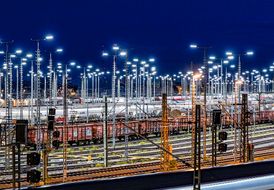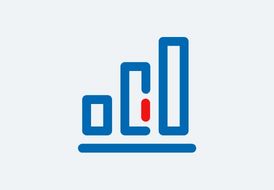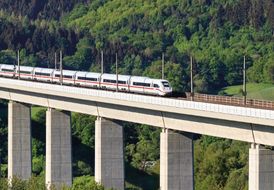Development in the relevant markets
German passenger transport market
In passenger transport, our objective is to maintain our strong market position in the rail and bus transport market in Germany in the long term and to take advantage of market opportunities in Europe.
| PASSENGER TRANSPORT MARKET IN GERMANY / % based on volume sold | Growth rate | Market share | ||
2021 | 2020 | 2021 | 2020 | |
Motorized private transport | +5.0 | –9.0 | 89.4 | 89.0 |
Rail passenger transport | +1.4 | –44.7 | 5.8 | 6.0 |
DB Group | –2.7 | –44.6 | 4.7 | 5.0 |
Non-Group railways | +23.1 | –45.1 | 1.1 | 1.0 |
Public road passenger transport | –0.8 | –37.6 | 4.5 | 4.7 |
DB Group | +8.8 | –35.7 | 0.5 | 0.4 |
Air transport (domestic) | –20.3 | –73.9 | 0.2 | 0.3 |
Overall market | +4.4 | –14.8 | – | – |
Figures are based on information and estimates available as of February 2022.
In 2021, the Covid-19 pandemic had again a serious impact on the German passenger transport market: ongoing contact and travel restrictions in the first half of 2021 led to a reduction in demand for transport compared to the first half of 2020. The trend finally reversed later in 2021, leading to growth for the entire passenger transport market on an annual basis. However, volume sold remained significantly lower than pre-Covid-19 levels. During the two years of the Covid-19 pandemic, people tended to prefer individual rather than public modes of transport. Mobility providers therefore reduced their services or suspended them altogether. The extent to which this happened differed across individual market segments.
- Motorized individual transport increased markedly in 2021 after a sharp decline in the previous year. While volume sold on long-distance routes fell in 2020, pre-Covid-19 levels were significantly exceeded during the summer months of 2021. During the course of 2021, motorized individual transport continued to benefit from the preference for individual modes of transport to protect against infection. The trend towards vacation within Germany also had a positive effect.
- Domestic German air transport remained on a subdued recovery path. Even in August, which was a strong month for travel, it only reached about 30% of its pre-Covid-19 levels. Supply and demand recovered extremely slowly, keeping the market share at a very low level.
- Rail passenger transport declined by up to 90% in some weeks of 2021 due to a lack of demand for commuter, private and business travel. The floods and the wage dispute with the German Train Drivers’ Union (Gewerkschaft Deutscher Lokomotivführer; GDL) also had a negative impact on volume sold. The market share held by rail passenger transport declined slightly.
- Regional rail passenger transport recorded noticeable losses due to a lack of private and commuter travel.
- Long-distance rail passenger transport was also characterized by the lack of demand for private and business journeys in 2021 due to the Covid-19 pandemic. The trend in 2021 was supported by gains in air and bus long-distance transport and the expansion of
available rail offers. FlixTrain suspended its service for several months until May 2021.
- Public road passenger transport continued to suffer from the lack of private and commuter journeys and from school closures, which resulted in the loss of many school journeys.
- With the support of the contracting organizations, however, a reliable basic service was provided at all times.
- Long-distance bus services came to a standstill for several months in 2021. FlixBus, BlaBlaBus and Pinkbus resumed a limited service, and Roadjet started as a new supplier with luxury buses.
- The market share of public road passenger transport fell slightly.
German freight transport market
| FREIGHT TRANSPORT MARKET IN GERMANY / % based on volume sold | Growth rate | Market share | |||
2021 | 2020 | 2021 | 2020 | ||
Rail freight transport | +8.3 | –7.3 | 18.5 | 17.9 | |
DB Group | +8.1 | –7.1 | 8.0 | 7.7 | |
Non-Group railways | +8.5 | –7.4 | 10.5 | 10.1 | |
Road freight transport | +4.0 | –2.2 | 72.4 | 72.7 | |
Inland waterways transport | +3.7 | –9.0 | 6.9 | 6.9 | |
Long-distance pipelines | –5.7 | –5.5 | 2.2 | 2.5 | |
Overall market | +4.5 | –3.7 | – | – | |
Figures are based on information and estimates available as of February 2022.
Volume sold in rail freight transport according to the Destatis definition of transport services that are primary freight carriers.
As expected, the overall strong development of freight transport lost momentum in the second half of 2021 as a result of decreasing baseline effects following the start of the recovery in late summer 2020. The demand for transport was stimulated by strong momentum from trading and industries such as steel and construction. Coal transport, which is important for rail and inland waterway transport, also recorded strong growth as a result of the increased use of coal in power generation. On the other hand, problems with the procurement of intermediate products and raw materials in the second half of 2021 had a detrimental effect. This was felt particularly strongly in the automotive industry. There were also downturns in mineral oil transport. Negative preemptive responses triggered by the introduction of the carbon tax at the start of the year and the expiration of the value-added tax (VAT) reduction at the end of 2020 were among the most noticeable effects. In addition, numerous extraordinary factors not associated with the macroeconomic environment also had a dampening effect. These included Storm Tristan in February 2021, disruptions to maritime transport, restrictions on freight train lines in the Middle Rhine Valley following a rockslide, and the GDL strikes. Nevertheless, freight transport performance in Germany recorded a strong rise for the year as a whole and exceeded its pre-Covid-19 level.
The weak performance of rail freight transport in the previous year was primarily driven by sharp declines in the iron, coal and steel, bulk cargo and automotive sectors. In 2021, however, there was an above-average increase in volumes. This dynamic development is mainly attributable to the recovery in the iron, coal and steel industry. There was strong growth in the transport of iron ore, steel and secondary raw material (such as scrap). Combined transport also contributed strongly to growth following the decline in the previous year. The coal/coke, chemicals and timber sectors also saw positive development. On the other hand, automotive transport again performed weakly, recording double-digit declines due in large part to the shortage of chips. Mineral oil transport also fell markedly, as in the sector as a whole. Based on the information available at the time of reporting, however, it can be assumed that the freight railways have already reached pre-Covid-19 levels and that above-average performance has allowed them to increase their market share following the losses in the previous year.
The development of non-Group railways lagged behind the intra-Group companies until autumn 2021. This is because iron, coal and steel transport, which are of much lesser importance for non-Group railways, recorded double-digit growth in some cases. Based on the currently available information, development across the entire year was somewhat stronger. According to our calculations on the basis of currently published figures, this is mainly attributable to combined transport.
Road freight transport recorded a weak start to 2021. In addition to the effects of the Covid-19 pandemic, this was also due in part to negative weather effects on the construction industry, which is of significant importance for the road transport sector.
As the economy recovered over the course of the year, however, growth gained noticeable momentum. Growth was boosted primarily by dynamic foreign trade and sustained positive effects from the consumer goods industry and e-commerce. Above-average growth was recorded for trucks registered abroad. Positive baseline effects also made a contribution, following the strict Covid-19 restrictions at borders in the previous year. Overall, road freight transport in 2021 exceeded pre-Covid-19 levels. The market share fell slightly compared to 2020.
After a weak start to the year, the development of inland waterway transport gained noticeable momentum overall from May 2021 onward. In industries that had declined severely in the previous year, such as coal, iron ore and stone/earth, the data published at the time of reporting for the period up to November 2021 showed strong growth. Although container transport tonnage increased slightly, volumes remained below the previous year’s level. However, its share of the total volume is too low to have a noticeable effect. Sharp declines in foodstuffs, drinks and tobacco, and in particular in coke/mineral oil products, one of the most important types of goods for inland waterway transport, had a negative effect. Development was also slowed by several weeks of low water on the Rhine in the autumn, which meant that ships were only able to sail with partial loads or were unable to sail at all. The sector has not yet returned to pre-Covid-19 levels.
European rail freight transport market
The effects of the Covid-19 pandemic caused volume sold in European rail freight transport (EU 27, Switzerland, Norway and the United Kingdom) to decline sharply in the previous year. In contrast, the European rail freight transport market saw very positive development in 2021, almost returning to pre-Covid-19 levels. This positive development was caused by the recovery of industrial production and trade as well as baseline effects following the sharp declines in the previous year. In 2021, strong momentum was recorded in the iron, coal and steel sector and the combined transport sector in particular, which was severely impacted in 2020. The recovery in international trade was mainly supported by growth on the European corridors to the North Sea ports of Antwerp, Rotterdam and Hamburg, the southern ports, and on the Eurasian axis.
| INTERNATIONAL FREIGHT TRANSPORT AND LOGISTICS MARKETS / % | Growth rate | |
2021 | 2020 | |
European rail freight transport (based on tkm) | +7.2 | –6.9 |
Figures are based on information and estimates available as of February 2022.
The positive development is also reflected in Germany, France, the United Kingdom and Poland, all of which are key markets for DB Cargo. Like DB Cargo, all other major railways in Europe significantly increased their volume sold.



